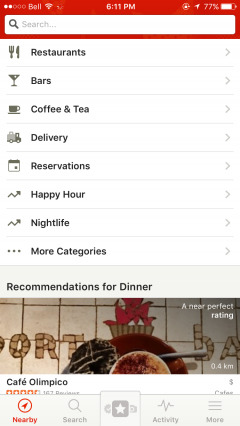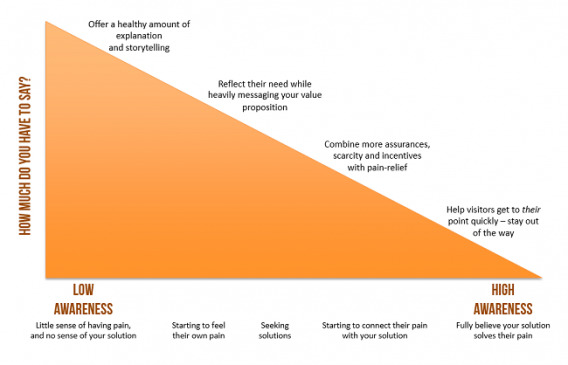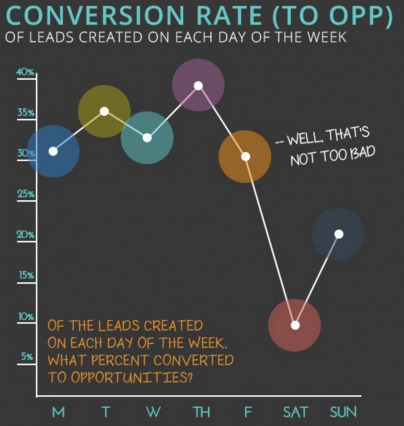When trying to boost conversions, whether it’s on a signup screen or a landing page, it’s a default for many optimizers to generate hypotheses based on best practices and what’s generally “known” to be a problem.
A landing page that doesn’t display well on mobile is a perfect example. Someone might shout “it’s not responsive” and then resize the page properly for mobile use.
But that won’t solve the real issue… because the truth about most low converting landing pages on mobile isn’t just that they don’t resize properly, but that they have been written, designed, built… with no mobile context in mind.
Table of contents
Why does context matter?
If a potential customer is commuting to work on a bus or train, and they have 5 minutes left until they arrive at work, are they really going to read your 5,000 word sales page on their phone?
We have to stop thinking about optimizing websites for “devices”. Ultimately, we’re optimizing for humans. So, instead, let’s optimize for context.
What is contextual relevance?
Contextual relevance refers to the adequacy and appropriateness of a piece of content that is presented to a customer, and how it fits with the timing, the stage of the buyer journey where the customer is at, the channel through which it is presented, and other conditions.
How to optimize for contextual relevance
Now, there are three main ways you can identify and optimize based on context.
1. Identify what visitors already know vs. what they need to know
This mostly comes down to copy. Before writing anything – emails, landing pages – you need to use language visitors recognize and understand. Most importantly, you need to make sure they understand the problem you’re solving.
In his book Breakthrough Advertising psychologist Eugene Schwartz divided the awareness level of a prospect into five different stages:
- The Most Aware: Your prospect knows your product and only needs to know “the deal”.
- Product-Aware: Your prospect knows what you sell, but isn’t sure it’s right for him.
- Solution-Aware: Your prospect knows the result he wants, but not that your product ensures it.
- Problem-Aware: Your prospect senses he has a problem, but doesn’t know there’s a solution.
- Completely Unaware: No knowledge of anything except, perhaps, his own identity or opinion.
Now here’s a common mistake: a SaaS company will try to sell its software through its features (thus, marketing as if the visitor is in the product-aware or most-aware stage) when the visitor is only in the problem-aware stage.
You’ll be completely missing the mark if your website isn’t attuned to the right stage in the user journey. Avoid this mistake at all costs.
How to avoid marketing your product at the wrong awareness level
The first rule is to never assume your visitors are problem- or solution-aware. In fact, you’ll probably be much safer if you market the problem before the solution.
My second rule is that even if your audience is already problem- or solution-aware, you still need to remind them of their “pain” and how it will continue if they do not purchase your solution. Decision-making doesn’t just come down to logic… emotions need to be taken into consideration no matter what you’re selling.
For every email I write, landing page I build and website I optimize, I use the P-A-S (Problem – Agitate – Solve) formula to ensure the problem is properly nailed down both on the logical and emotional levels before I do the hard sell.
When using the P-A-S formula, you’ll want to follow this exact order whenever you’re writing copy:
- You have to begin with the problem. Do not start by mentioning your product or its features. Your first priority is to clearly state the problem you’re solving, your audience’s problem.
- The second step is to agitate the problem, or as I like to say, twist the knife. Again, you want to state the problem, but you want to make it even more urgent. What happens if the problem doesn’t get solved? How painful is the impact of inaction? How is this going to affect your prospects’ jobs, lives? Use facts, but also make sure to mix in plenty of questions and statements that dig into emotions (e.g. How would that make you feel?, What would you do?, Imagine…)
- The third step is where you will solve the problem you’ve presented. Yes, that means you can start talking about your product. Make the product you are selling the obvious, no-brainer solution to the problem you’ve described. Always aim to talk about the benefits more than the features. Make your audience feel hopeful that their problems will be solved with the purchase of your product.
Copywriter Demian Farnworth wrote on his blog how he’d use the P-A-S formula to sell Crazy Egg, a heatmap tool:

Now next time you write sales copy, make sure you’re not putting the cart before the horse. Through qualitative research such as surveys, polls and interviews, identify your prospects’ awareness levels. Go further by pinpointing the language they use at each awareness level.

I highly recommend mapping out everything your audience needs to know in order to be able to make a buying decision. Then, in reverse, break down every piece of information into either blog posts and drip emails to educate and move them up through the awareness stages. Prepare them to buy.
2. Don’t just know the traffic source, know the context of the traffic source
A few clicks in Google Analytics will tell you where your highest converting visitors come from. Great, but now what? How do we turn the data from traffic source reports into actionable marketing moves?
By identifying the context.
Let me explain what I mean by that…
Instead of simply understanding where your visitors come from, analyze those traffic sources and understand what mindset your visitors had when browsing that source of traffic.
Ask yourself these questions:
- Why were your visitors on that website? What were they looking to accomplish?
- What were they thinking while browsing that source of traffic?
- What did they read or learn on that previous website?
- How and why did they end up on your site?
Understanding the answers to these questions will allow you to continue enhancing the visitor’s experience and possibly leverage their experience on the previous website to further personalize your content to increase familiarity and – hopefully – sales.

I’ve recently successfully implemented this concept on a client’s website and conversions increased by 55%.
The company wanted to get more users for one of their online security tools. I knew their website’s biggest traffic source is search engines and that people were searching queries like “my gmail account got hacked”.
So, we combined these insights with surveys and polls, and ultimately discovered people were looking for a solution to recover their accounts, and fast!
With that taken into consideration, our research showed that people didn’t read long posts… they wanted answers, to solve their problem quickly.
The company had step-by-step guides on recovering your account from hackers, so we made some of the guides more concise (i.e. removed some of the problem-awareness content as it was clear they knew their problem).
Then we added content that promoted the security tool, but integrated it within the format and context of the blog post.

This provided value to the visitor, a quick solution. And for the client, the results speak for themselves.
3. Get to know your visitors’ environments
On any page that your visitors browse, be mindful of their environments.
For example, a visitor’s attention span will be much shorter on mobile than desktop, which means the content you display should be different. From the text to the images.
This will also apply to the time of day that someone is browsing your website. Depending on what you’re selling, think about how the behaviors and goals of your visitors will vary through hours of the day and days of the week. Run polls to validate.
For example, Yelp does simple, but brilliant personalization of the content it displays based on geo-location and the time of day in order to remain as relevant as possible.

You also want to think about the surrounding environment of your visitor. Are they at home or at work? Sitting or walking? In a hurry or just browsing?
Imagine you run a B2B company… chances are that behavioral patterns between weekend visitors and weekday visitors will be much different.
First of all, your traffic might be lower on the weekend. Also, as I have observed with many of my B2B SaaS clients, conversion rates might be lower on the weekend too. That’s to be expected since the majority of people don’t work on the weekends.
Bizible studied how the weekend impacted volume of leads and conversions for B2B businesses, and they found this to be true: conversions were significantly lower on the weekend.
So what can you do with this information? Well, during the weekend, instead of trying to get the conversions that require the approval of multiple people, why not display a call to action that requires a smaller commitment?
You could, for example, grab email addresses on Saturdays and Sundays, and then email the person during the week, when you’ll have their full attention.
Conclusion
Context is an important, yet frequently overlooked, factor when it comes to increasing conversions. Without an understanding of the visitor’s context, the meaning of your value proposition is muted and minimal.
Here’s what you can do to better understand context and use it to increase conversions…
- Continuously ask yourself what your visitors’ goals, motivations and needs are. You need to know their awareness levels.
- Use qualitative research methods to validate your hypotheses. Use this data to guide your website’s copy and design.
- Optimize for human behaviors as a whole, not just for devices and browsers, and then increase relevancy through personalization.






Excellent article Raphael.
It is very important to understand Context as you highlighted in the article.
I wanted to know how do you make out which awareness levels the reader belongs to? If you are getting traffic from Google you can probably look at Keywords. But what about traffic from other sources? What kind of questions to ask these visitors to gauge their awareness levels?
Hey Mohit,
Glad you liked the post! To answer your question, there are many ways to determine the awareness level of the reader.
Now, yes, looking at search queries is a way to do it. However, my favorite methods (and I believe the most effective) are surveys and interviews (if you decide to do phone interviews, you’ll notice it’s easier to detect nuances in answers).
This answer could be a whole blog post, but in short, ask questions about their problem, the solutions and your company/offer.
For example, if you ask what’s the single biggest challenge they’re experiencing (related to X), someone who is well aware of their problem will provide more details and be clearer in their answers.
Then you can ask them what they’ve tried to solve that problem, what they’re thinking of trying, and so on. This will help you find out how well they know how to solve the problem.
Finally, to determine how familiar they are with your offering, you can ask them questions about the offer itself. Of course, the questions here will vary greatly depending on what your offer is.
At the end of the day, the most important question you can ask yourself is “What does my visitor or prospect already know”.
Again, using qualitative surveys as I wrote above, and analyzing the questions you get from support tickets and calls will help you determine this.
My rule of thumb is to never assume the prospect is fully aware of anything.
Thanks for reading, and hope this helps!
Hi everybody,
My name is Lincy and I’m writing you to ask for the advice…
Recently we started a Social Whisper http://socialwhisper.net project (it is a social project and a kind of “fair” social network where people fill profiles for their friends). We’ve just launched it and now looking for somebody to help us with promotion.
Recently I’ve heard about growth hacking and this is exactly what we are looking for. So my question is – what would you advice for such site promotion?
Thank you in advance for your time!
Kind regards,
Lincy
Raphael, fantastic post and reminder how to look at various stages!
Looking forward to hear from you in the future too.
Thanks a lot for the good words Sandis!
That was a great post! (I know because I almost never take notes.) I really like the awareness scale — I developed something similar but it was more “awareness of us” and didn’t include awareness of the problem. I will tweak mine to include — thanks for the thought provocation!
Thanks for reading George, the “awareness of the problem” part is definitely important – it’s the foundation for the rest. Good to add it to your own scale!
Great advice on how to factor in contextual relevance, Raphael, thanks for that! I’m going to try and apply it this week.
Thanks for reminding me to dig into my copy of Breakthrough Advertising as well!